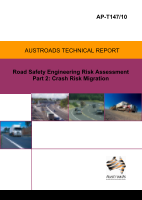Road Safety

Road Safety Engineering Risk Assessment Part 2: Crash Risk Migration
- Publication no: AP-T147-10
- ISBN: 978-1-921709-01-2
- Published: 18 January 2010
- PDF (free) Download
This report provides an overview of the effect known as crash risk migration (CRM). It is intended to build an understanding of the potential for CRM to occur as a result of road safety treatments. It is also intended to inform current approaches to evaluating road safety risk. In particular, evaluation approaches generally examine the extent to which a safety issue at a treatment site can be addressed, without considering the possibility that some treatments may impact crash rates at other locations. This report focuses on situations where CRM may occur as a result of traffic redistribution.
- 1. INTRODUCTION
- 1.1. Objectives
- 1.2. Method
- 1.3. What is Crash Risk Migration?
- 1.3.1. What Causes CRM?
- 1.4. Structure of Report
- 2. REVIEW OF ISSUES AND TREATMENTS
- 3. LITERATURE REVIEW
- 3.1. Confounding Factors in Outcome Evaluation Research
- 3.1.1. Confounding Factors in CRM Research
- 3.2. Treatment Studies and CRM Effects
- 3.2.1. Bridge Closure
- 3.2.2. Lane Additions
- 3.2.3. Speed Limit and Speed Environment Changes
- 3.2.4. Pedestrianisation
- 3.2.5. Pedestrian Crossings
- 3.2.6. Grouped Countermeasures
- 4. DETECTING AND MEASURING CRM
- 4.1. Step 1 – Consider Treatment Type
- 4.2. Step 2 – Identify Potential Mechanisms for CRM
- 4.3. Step 3 – Establish Context
- 4.4. Step 4 – Consider the Spatial Extent of the Effect (Area of Influence)
- 4.5. Step 5 – Experimental Design
- 5. POSSIBLE FUTURE RESEARCH PROGRAM
- 5.1. Program Objective
- 5.2. Sub-programs
- 5.3. Deliverables
- REFERENCES
- APPENDIX A AUSTROADS ROAD SAFETY ENGINEERING RISK ASSESSMENT PROJECT
- APPENDIX B OVERVIEW OF THE EMPIRICAL BAYES METHOD
Related publications
Latest Road Safety News
